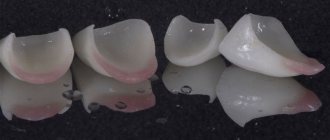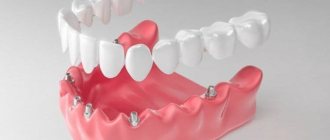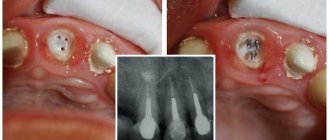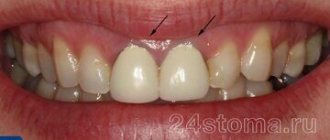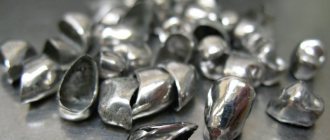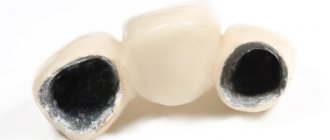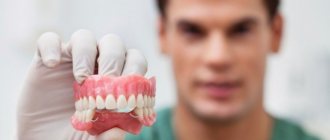Not everyone manages to keep their teeth intact throughout their lives. When teeth are lost, the patient loses the ability to smile beautifully, and he experiences disturbances in speech and chewing functions. Orthopedic dentistry is designed to solve these problems. Restoration of the structure and functions of the masticatory apparatus occurs through the installation of orthopedic structures. Modern designs for prosthetics completely replace lost teeth. They are adaptive, hypoallergenic, and have a long service life.
Indications for installation of a prosthesis
The general indication for prosthetics is damage or absence of a certain number of dental units. Dental defects lead to ineffective chewing of food. The bite is disturbed, the aesthetics of the smile suffers. The most common indications for prosthetics are the following disorders:
- Adentia (complete or partial loss of teeth). Restoration of the dentition is carried out by removable prosthetics or implantation of dental units.
- Complete or partial destruction of the coronal part of the tooth, in which filling is impractical. When preserving the root, a pin structure or stump tab is used.
- Pathological abrasion of enamel, which is a systematic violation of the enamel layer of dental units. The loss of hard dental tissues leads to malocclusion.
- Traumatic damage to teeth. The patient may be offered various options for restoring the dentition, depending on the severity of the situation.
- Pathology of the alveolar process leading to serious malocclusion. A frequent consequence of partial edentia, leading to the restructuring of the alveoli and a decrease in the functionality of the dentition.
- Single and multiple dental defects. The patient can be offered various design options depending on the existing problems.
Prosthetics
Installing dentures is a method of restoring a flawless smile that is suitable for almost anyone. There are much fewer contraindications here than with implantation. The main thing is to correctly determine which prosthesis you need.
.
First, you need to understand whether you need removable or fixed dentures. The latter are not suitable for every patient, since, for example, if too many teeth are missing, their installation is impossible due to lack of support.
Removable dentures
Acrylic
© bedya / Fotolia
The main contraindication for their installation is an allergy to acrylic.
Their service life is 5-8 years. In general, patients using this type of prosthesis are satisfied with their lightness
and at the same time
durability
.
It is noted that they are easy to care
: Dentures can be easily removed from the mouth and cleaned. It is almost impossible to distinguish them from real teeth.
At first, some people experience discomfort when wearing them, they have to use special ointments to prevent the dentures from rubbing their gums, but soon this is no longer necessary - the discomfort disappears.
Among the positive features, patients also mention the price: as a rule, it is much lower than the cost of other types of prosthetics
; However, it cannot be said that the quality is much worse.
What are the prices for teeth augmentation procedures? Let’s look at the most “significant” components of cost.
Want to find out how to treat periodontal disease at home? Read the information prepared by our specialists.
Here: https://www.vash-dentist.ru/lechenie/zubyi/lz-mudrosti/simptomyi-prorezyivaniya.html - the main symptoms of wisdom tooth inflammation are given.
Nylon
Their advantages include not the highest price, ease of installation and easy maintenance
.
Typically, their wearers note that after installing the prosthesis, there is no discomfort either when communicating or when chewing food, and besides, they look the same as real teeth.
. In addition, their undoubted advantage is hypoallergenicity: even people with allergies to various materials, which did not allow them to insert many other types of prostheses, can use them.
They are very elastic, which, however, is not always good: some patients experience pain due to this quality. But it is worth noting that, regardless of the type of prosthesis or implant, the presence or absence of discomfort, pain or other unpleasant sensations in most cases is associated with high or low professionalism of the dentist.
© Ocskay Bence / Fotolia
Polyurethane
Their properties are similar to nylon ones, but thanks to domestic production they are even cheaper. Patients note that much less money is spent on their installation than nylon ones. At the same time, reviews indicate that the strength of polyurethane prostheses is much higher.
Perhaps this is the most suitable option for those who want to spend as little money as possible on this procedure, but also do not want to install short-lived prostheses
.
Clasp
Such prostheses can withstand heavy loads, so they will fully satisfy patients who prioritize reliability and durability.
Clients of dental clinics who have chosen this type of prosthetics are satisfied with the fairly quick adaptation to artificial teeth. Some people don’t even take them off at night – these prostheses are so comfortable.
In addition, even after prolonged use, the teeth do not become loose, apparently precisely because the dentures evenly distribute the load on the jaw
.
We can learn in detail what clasp dentures are from the following video:
Prostheses "Quadrotti"
Their advantages over other types are an attractive and natural appearance, reliable fixation, flexibility, and ease of use, which are noted by those who use such prostheses. Patients get used to them, like clasp ones, quite quickly (some even note that they did not feel them in their mouths the very next day after installation).
Reviews show that the installation of Quadrotti prostheses is well suited for people whose professional activities involve public speaking, frequent communication with clients, or negotiations
. As noted, after their installation, speech does not change at all.
Fixed dentures
Crowns
Patients who are interested in crowns that look as natural as possible should give preference to ceramic products. They look quite aesthetically pleasing and are also stronger compared to metal-ceramic ones.
Experts note that, unlike metal-ceramic crowns, these crowns do not oxidize over time, which ensures an increased service life. True, they are, of course, more expensive.
Among those who wear crowns, ceramic products are most often preferred. Many people replaced metal-ceramics with all-ceramic crowns on their teeth due to the inconvenience of use and were satisfied that they were not only more comfortable, but also looked more natural.
© Tnt/Fotolia
Bridges
This option is suitable for people who have problems with several teeth at once. However, do not forget that when installing a bridge, you will definitely have to grind down the adjacent teeth.
When choosing the material from which the bridge will be made, patients using them recommend starting from whether it will be visible in everyday communication
. So, if, for example, when you smile you will inevitably show off your dental bridge to others, then it is better to install a zirconium one.
If the bridge is placed in place of teeth, which are usually very difficult to notice, then you can install ordinary metal-ceramics: it is much cheaper, and in this case there is simply no point in overpaying for zirconium.
Let's figure out which dentures are the best in terms of price and quality.
In our article you will read how and whether it is even possible to treat pulpitis with folk remedies.
Here: https://www.vash-dentist.ru/protezirovanie/semnyie-p/pokryivnyie/zubnyie-vidyi-osobennosti-i-tsenyi.html - it’s easy to find out how much an overdenture costs.
Tabs
They should be used by those who need to restore a dilapidated tooth.
Patients note that dental inlays completely follow the shape of the tooth and are invisible in the mouth. However, their advantages include not only their appearance. Their users are satisfied with the long service life of the tabs.
Veneers
This is a good method to hide a defect on the front side of a tooth.
People who have installed veneers to eliminate external defects in the dentition claim that their use has improved the color of the surface of the teeth, eliminate curvatures, hide the distances between teeth and simply make the smile more beautiful and attractive.
Types of prostheses
Modern orthodontics offers many types of dental restoration. Each method has its own advantages and disadvantages and is used to solve a particular problem. The type of prosthesis and method of prosthetics are selected by the attending physician together with the patient, based on the clinical situation, budgetary capabilities and patient preferences. Orthopedic structures are distinguished by the method of fixation, the material of manufacture, the defect being replaced, and the type of fastenings in the oral cavity.
Classification by method of fixation
Based on the method of fixation, a distinction is made between removable and non-removable structures. A very special type is fixed dentures on implants.
- Removable structures. They can be removed from the mouth independently. They solve the problem of the absence of one or more units in the dentition. Inexpensive and easy to care for.
- Fixed structures are permanently fixed in the oral cavity. They are durable, strong and efficient. They have a higher cost.
- Implantation is the most complex and expensive type of prosthetics. Implants are a multi-component structure that is inserted into the bone tissue of the jaw and replaces the root part of the teeth. On their basis, the restoration of the dentition is carried out.
Classification by material of manufacture
In modern dentistry, many materials have been developed for the manufacture of prosthetic structures. Here are the four main types:
- Plastic structures are made from polymerized acrylic. This lightweight and durable material is inexpensive and available. The lightweight porous structure ensures a tight fit, which significantly reduces the adaptation time. Under heavy loads, plastic prostheses are prone to loosening and are therefore short-lived. Used for temporary use.
- Nylon prostheses are made from soft, hypoallergenic synthetic material. They are secured in the mouth using special clasps. The disadvantage is its short service life. The chewing load is distributed unevenly, which can lead to bite problems.
- Zirconium dioxide structures. Zirconium dioxide is a durable natural mineral, naturally enriched without the presence of synthetic impurities. Used for the preparation of fixed dentures. It has many advantages: it holds the chewing load well, its shade is close to natural enamel, and it has low thermal conductivity. Zirconium dentures are not used to treat severe malocclusions, since a strong crown begins to destroy neighboring teeth.
- Ceramic dentures are made from specially treated ceramics with the addition of lithium disilicate. The crown material is very durable and reliable, its structure is closest to tooth enamel. Ceramic dentures have the highest aesthetics, therefore they are used for prosthetics in the smile area.
Classification of dentures according to the volume of the replacement defect
Depending on the clinical situation, the patient may be indicated for a complete or partial denture:
- Complete dentures are removable or conditionally removable structures used in the absence of all units in the dentition. A complete denture simulates the entire dentition. The base of the prosthesis rests on the gums and helps fix the structure in the oral cavity.
- Partial dentures help restore dentition when several teeth are missing. They imitate a fragment of the dentition, replacing several nearby missing dental units or teeth lost in different parts of the jaw.
Classification of prostheses by type of fastenings
Depending on the method of fastening the prosthesis in the oral cavity, the functional load on the supporting tissues is distributed differently. The following types of orthopedic structures are distinguished:
- Lamellar dentures are a type of removable structures. Effective for partial or complete edentia. They differ in the material of manufacture and the method of attachment in the oral cavity. Attached directly to the mucous membrane.
- Bridges are non-removable structures used in cases where several dental units are missing in a row. They are attached to dental units spaced apart from each other and ground for crowns.
- Supported or clasp dentures are distinguished by a special way of transferring the load: through the supporting teeth, periodontium and mucous membrane. This method is called semi-physiological.
Which crowns are suitable for chewing teeth?
Crowns for chewing teeth must have an important property - strength. It is the distant elements, the molars, that bear the main load. Therefore, the reliability and strength of the prosthesis to perform the important chewing function is the main criterion for choosing which crowns are best placed on the teeth.
- metal.
The cheapest option (if it is not gold or an alloy of precious metals). Low aesthetics, but reliability on a limited budget - an acceptable solution for chewing teeth. Don't forget about metal allergies in some sensitive patients. Then you should think about another choice. - metal-ceramic.
A popular solution to the question of which crown to put on chewing teeth in terms of price and quality ratio. Really. The metal base is strong, suitable for loads, and the ceramic layer does not distinguish the dentures from other teeth. The disadvantages are possible allergic reactions to metal, blue discoloration in places of contact with gum tissue. The solution is inert metals for the frame. But this increases the cost of a metal-ceramic crown. - ceramic.
Classic ceramics are not suitable for heavy chewing loads. But E-max crowns made of pressed ceramics are successfully placed on molars. With such porcelain teeth you can smile very widely. Crowns perfectly imitate neighboring teeth. - zirconium.
The best choice is to put crowns on chewing teeth made of zirconium dioxide. This is due to their excellent durability and aesthetics. For molars and back teeth, monolithic dentures are used that can withstand heavy loads for many years.
How to choose the right dentures
The selection of a denture is made by the attending dentist together with the patient. After the initial examination, the doctor assesses the clinical situation and advises the patient, explaining what type of prosthetics is indicated for him. The patient makes a decision taking into account the doctor’s recommendations and his preferences.
Doctors at the Consilium Dent dental clinic will provide a free initial consultation on the selection and installation of orthopedic structures. After the initial examination, the dentist will select the optimal prosthetic option and advise the patient on how to prepare for prosthetics. He will talk in detail about how to care for the oral cavity during and after prosthetics. When choosing, the number of missing teeth, the condition of the tooth bed and gums, financial capabilities and the desire of the patient are taken into account.
Review of the advantages and disadvantages of palateless dentures
The main advantage of removable dentures without a palate is the convenience and safety of the design for the patient. After the restoration procedure, the patient quickly gets used to the installed prosthesis, normal diction is maintained, and there is no unpleasant sensation of strong pressure on the soft tissues of the oral cavity. A removable denture without a palate will ensure optimal distribution of the chewing load and this will reduce the risk of rapid bone tissue atrophy.
There are also disadvantages to removable dentures without a palate. For example, high price. The service for prosthetics with an innovative system will cost more than the installation of plastic or nylon prostheses. It is also worth knowing that for prosthetics with removable dentures without a palate, the presence of supporting teeth is mandatory.
Removable dentures. What to prefer?
If all or a significant part of the teeth are lost, the patient will be offered the installation of a removable denture. The removable design is a plastic plate that fits tightly to the mucous membrane and follows its shape. This ensures its strong attachment in the oral cavity. Artificial teeth are attached to the plate, imitating the patient’s own lost dental units. There are two types of removable structures: partially removable and completely removable.
The best partially removable designs
Partially removable dentures are used for partial restoration of the dentition. This type of denture is indicated if only part of the teeth are missing. Plastic and nylon are used for manufacturing. Special hooks or special clasps are used as fastening means. The fasteners are quite strong and provide reliable fixation of the dentition.
Main advantages and disadvantages
Partially removable structures are universal and have many advantages:
- The chewing load is evenly distributed, which ensures the safety of the dentition.
- The oral care procedure is simple and easy.
- Durable clasps provide reliable fixation in the oral cavity.
- The prosthesis ensures complete restoration of chewing function.
- Due to the uniform load, deformation of some dental units is excluded.
Among the disadvantages are the following:
- Dentures are quite expensive.
- Not all designs are sufficiently aesthetic, so they are not suitable for restoration of a row in the smile zone.
- Dentures require periodic adjustments.
Removable structures for complete dentures
This type of structure is used for complete restoration of the dentition in cases of total edentia. These are light and durable dentures that are in good contact with the oral mucosa. Typical denture materials used for complete dentures are nylon or acrylic. The fastenings are made in the form of so-called suction cups.
Advantages and disadvantages
Among the advantages, the following should be noted:
- The designs are easy to manufacture, which determines the low price.
- In case of breakdowns or damage, they can be easily restored.
- Cover a significant part of the sky, which makes contact very reliable
- Easy to care and use.
There are also a number of disadvantages:
- The structures wear out quite quickly, since the work of the masticatory muscles is not always coordinated.
- Due to constant pressure, the volume of tissue in the jaw joint gradually decreases. This impairs the retention of the prosthesis, and it may fall out when speaking.
- If the prosthesis is not positioned correctly, pain may occur in the mouth.
Let us compare the removable structure made of acrylic and nylon.
- Acrylic processes are more affordable.
- Acrylic dentures can break over time, while nylon dentures are made of flexible and durable material, so the likelihood of breakage is minimal.
- An acrylic prosthesis does not deform; a nylon prosthesis can change shape.
- Nylon has a smooth structure, does not absorb odors, does not stain, and is non-toxic. Acrylic is a more porous material and is susceptible to staining and staining over time.
- The color of nylon is closer to the shade of natural enamel and looks aesthetically pleasing. Acrylic has a wide range of shades; it is possible to choose an option that is as close as possible to the individual shade of the teeth.
- Nylon constructions are more hypoallergenic than acrylic ones
Removable dentures without palate
Sandwich dentures are designed for partial prosthetics and are an arch made of dense polymer that imitates the jaw arch. They are fixed to the molars that are preserved on both sides of the jaw. The fasteners are telescopic crowns that fit tightly and fix the product.
The advantage of these designs is that they leave the palate and sublingual space free, which ensures the preservation of diction and the natural sensitivity of taste buds. In some patients, such prostheses cause a gag reflex, which can make wearing difficult. Such patients are recommended to opt for the clasp system.
Which removable dentures are better – acrylic or nylon? Comparison of designs and reviews from experts
What type of dentures is better - nylon or acrylic? Patients often turn to dentists with this question, finding it difficult to make a choice on their own. The answer to this pressing question will depend on in which area of the oral cavity restoration is required and what kind of restoration it will be - complete or partial.
If it is necessary to carry out prosthetics with complete edentia, then it is more advisable to opt for acrylic removable dentures - they stay in the oral cavity better due to the “suction cup” effect. But nylon and acrylic removable dentures are equally poorly suited for restoration in the area of the lower jaw bone - the products simply cannot be firmly fixed in this area. Therefore, here it is best to consider a fundamentally different type of structure - clasp dentures or dentures on implants. Nylon prostheses are inferior to plastic structures in terms of ease of use and durability. When using them, patients are more often concerned about painful relationships, and the care of a soft polyamide prosthesis requires more complex and specific care.
However, removable dentures made of acrylic are not suitable for the restoration of lost dental units with single prosthetics. The clasps of the prosthesis will be clearly visible, which can cause psychological discomfort to the patient. Therefore, for single dental prosthetics in the smile zone, preference is given to clasp or nylon products.
Expert advice
There is no clear answer to the question of which prosthesis to choose in a given case. The structural features of the patient’s jaw apparatus, his age, and the severity of the problem are of great importance. Approximate recommendations are given in the table:
| Situation | Type of prosthetics |
| Clinical picture | Recommended type of prosthetics |
| Availability of dental units suitable for fastening the structure | Conditionally removable prosthesis |
| The dentition lacks a large number of dental units, and the installation of bridge-like structures or implantation is impossible | Removable prosthetics |
| Molars or incisors are completely absent from the dentition | Removable prosthetics. It is recommended to choose acrylic dentures |
| Molars and premolars are missing | Partially removable prosthetics |
| Requires installation of temporary prostheses | Partially removable prosthetics |
Implantation
© rommma / Fotolia
The advantage of implantation over conventional prosthetics is that it is a more effective method of tooth restoration. Patients who are not satisfied with the fact that dentures must be changed periodically should opt for implantation.
The difference in their payment is that with prosthetics you will have to pay separately for each procedure for replacing the prosthesis, while for an implant you will have to pay the entire cost at a time.
For this reason, it seems that implantation is more expensive, although in fact in the end the amount spent on prostheses will not be much lower.
However, there are health restrictions on carrying out such manipulations, since, in essence, they represent an operation.
Among the opinions of people who have decided to undergo implantation, there are many rave reviews about this procedure. Undoubtedly, its result impresses patients: even the most durable and durable prostheses, in their opinion, cannot be compared with implants in terms of service life. Like dentures, they require special care, but they do not need to be replaced every few years.
.
In addition, people are pleased that this procedure does not require grinding down adjacent teeth. At the same time, the implant looks aesthetically pleasing and natural and fully replaces real teeth.
Let's find out what dentists themselves say about dental implantation:
Fixed dentures. Which ones to choose?
Fixed prosthetic structures are firmly fixed in the patient’s oral cavity with cementing material and are not intended for self-removal. There are three main types of fixed structures: crowns, bridges, microprostheses.
Crowns
A dental crown is a non-removable orthopedic structure of a natural shape that covers the coronal part of a tooth or a separate area of its surface. Crowns are made from high-quality materials: metal, zirconium, porcelain, ceramics, plastic.
Advantages and disadvantages of crowns
The main advantage of dental crowns is that they are able to completely restore the functionality of the dentition. Other benefits include:
- strength;
- aesthetics;
- low price;
- long service life
Among the disadvantages of structures of this type are:
- metal crowns are not aesthetically pleasing enough, so they are not used in the smile area;
- it is not always possible to choose a design color that fully matches the color of natural enamel;
- in some cases it is necessary to sharpen the tooth.
Bridge structures
A bridge is a type of fixed prosthesis used to replace significant defects in the dentition. A bridge rests on two dental units spaced apart from each other and replaces several destroyed, consecutive dental units.
Advantages and disadvantages of bridges
Bridges are structures that are designed for use in cases of significant defects in the dentition. This quality determines the main advantages of the structures:
- When chewing, the load is evenly distributed, determining the long service life of the prosthesis.
- The use of a bridge helps prevent atrophic processes in bone tissue. They begin due to insufficient load on the jaw in the absence of a significant number of dental units.
- A bridge can ensure normal grinding of food during chewing, and therefore maintain the health of the patient’s digestive system.
The disadvantages of bridges include the following:
- A structure that replaces several dental units is quite expensive.
- Teeth that serve as support have to be ground down and depulped even if they are healthy.
Microprostheses
Microprostheses are microstructures made of ceramic or composite material that serve to restore the damaged part of the tooth surface. These include dental inlays, veneers and lumineers.
Microprosthetics is a gentle technology designed to preserve severely damaged teeth. It allows you to protect the front wall of the tooth and restore the aesthetics of the dentition.
Advantages and disadvantages of microprostheses
The advantages of microprosthetics are obvious:
- A microprosthesis effectively hides defects and strengthens the tooth, which prevents its further destruction.
- An ideally selected shade makes the tooth indistinguishable from other units of the dentition.
- Microprosthetics does not require grinding of teeth.
The disadvantages are:
- Microprosthetics cannot be used for carious teeth.
- The cost of the procedure is quite high.
When choosing the appropriate type of prosthetics, the dentist aims to solve the patient’s problem in the most acceptable way.
| Situation | Type of prosthetics |
| One or more incisors are destroyed | Dental crown made of ceramics |
| Completely missing dental unit | Bridge prosthesis |
| Chipped edges of the tooth | Microprosthetics (veneers) |
| Chewing teeth destroyed | Dental crown. Recommended materials: metal, metal ceramics |
Tooth crowns: which ones are better in price?
The cost of crowns consists of materials, technologies and equipment used, as well as the qualifications of the doctor and the level of the clinic where the treatment is performed.
Types of crowns for teeth and which ones are better in terms of cost
| Type of crown | Price |
| Metal crown | 3,000 rubles |
| Metal-ceramic crown | 7,000 rubles. Metal-ceramics with shoulder mass - on average from 12,000 to 14,000 rubles, but may cost more (depending on the alloy and manufacturing technology) |
| Gold or platinum crown | 15,000 rubles. The upper threshold can reach 40,000 - 50,000 rubles |
| Ceramic crown | 15,000 rubles for standard crowns. Using Empress technology - on average 20,000 - 23,000 rubles |
| Zirconium dioxide crowns | 25,000 rubles |
You can view all prices for dental crowns here.
Which prosthesis to choose: removable or fixed?
Knowledge of the advantages and disadvantages of removable and fixed structures will help you choose the optimal type of prosthetics
| Kinds | Advantages | Advantages |
| Fixed structures | High level of reliability | There is a need to grind down adjacent teeth |
| Quick adaptation to the prosthesis and comfortable wearing | Sometimes the mucous membrane rubs when worn, making correction difficult | |
| High aesthetics | While the process of adaptation is underway, changes in diction and taste of food may be observed. | |
| The chewing load is distributed evenly | High cost with good quality material | |
| Easy to care for | When installing metal crowns, a metallic taste in the mouth is possible. | |
| With proper care, a long service life will be ensured. | ||
| Removable structures | Maintenance is simple and easy | Over time, the denture may become dislodged when eating. |
| Low cost | There is a risk of developing stomatitis | |
| The installation procedure is short | In some cases it is necessary to use a fixing paste | |
| Periodontal disease is not an obstacle to installing a prosthesis | When worn, a gag reflex may occur | |
| This type of prosthesis can be manufactured quickly | When worn, the shape of the face may change |
The choice of the type of prosthesis for each patient occurs individually. Dentists recommend paying attention to removable structures for the following problems:
- with complete or partial edentia;
- if there are pathological changes in the periodontium;
- if oral care is not thorough enough;
- if there are terminal defects of the dentition.
- in case of financial difficulties.
Fixed dentures are recommended for choice in the following cases:
- when no more than one or two units are missing in the dentition;
- if there are significant chips in the enamel;
- with pathological abrasion of enamel;
- with yellowed enamel;
- if it is necessary to restore the smile area;
- in the presence of carious teeth.
Dental dentures “Acry-free”
Innovative removable dentures are “Acry-free” dentures. These are elastic and flexible products made from unique raw materials based on acrylic resin. Acrylic gives the finished structure the necessary strength, rigidity and ensures its durability during operation.
Acri-Free removable dentures are often confused with products made of nylon or plastic, but this is a mistake: the designs have individual quality characteristics and are also easy to restore if the system breaks down. The material for making removable dentures Acry-free is biocompatible with the tissues of the oral cavity and is identical in color to the shade of the gums, which makes the finished structure aesthetic and invisible to others.
Choosing Acri-Free removable dentures is advisable if you have the following indications:
- An individual allergic reaction in a patient to metal alloys and plastic.
- The loss of both one tooth and the complete loss of dental units in rows.
- Periodontitis and periodontal disease. Installing a removable denture for this pathology will help prevent the process of further loosening of the teeth.
- Acri-Free soft prostheses are recommended for people whose professional activities are associated with an increased risk of injury.
Removable dentures of this type are valued by professionals for a significant number of advantages. In particular, the system may be used in prosthetics in cases where the patient has serious gum disease. Acri-Free structures are firmly fixed in the mouth, easy to repair, and the material they are made of does not cause allergic reactions or irritation of sensitive tissues of the oral cavity.
The advantage of Acri-Free is its excellent indicator of the tight fit of the products to the prosthetic bed, which eliminates the manifestation of pain when eating and helps to ensure proper functioning of the masticatory muscles. To install the system, it is not necessary to pre-file healthy teeth, and the prosthesis itself does not sag, does not absorb moisture, and pathogenic bacteria and foreign substances that can stain or damage the product do not penetrate into it. The structures do not require specific and labor-intensive care, their cost is lower than that of nylon removable dentures and, if desired, you can leave the denture on at night.
The only disadvantage of Akri-Free removable dentures is that their constant use will lead to gradual atrophy of bone tissue. But this disadvantage is characteristic of all types of systems used in removable prosthetics.
Popular questions about prosthetics
Here are collected popular questions from patients about prosthetics asked on the site forum. Experienced dentists answer.
Which prosthesis to choose: plastic or silicone?
Silicone has a short period of adaptation, is comfortable to wear, and does not rub the gums. Disadvantage of silicone: caring for them is more difficult.
Which type of prosthesis is better: a bridge structure or a suction cup prosthesis?
If there is a problem of missing several dental units in a row, the optimal choice would be a bridge. It will ensure uniform distribution of the load on the jaw, will serve for a long time, and is comfortable to use.
Which prosthesis to choose: plastic or nylon?
It all depends on which dental units need dentures. For chewing teeth, acrylic plastic is more suitable as the most durable and comfortable material to wear. Nylon dentures are suitable for premolars and incisors.
Which prosthesis design should I choose from plate-type prostheses?
If a temporary prosthesis is needed, then a removable plate structure is chosen. A fixed prosthesis is chosen in the absence of at least three dental units in a row in the dentition.
Which denture should a person prone to allergies choose: acrylic or nylon?
Nylon has more hypoallergenic properties. In addition, a nylon prosthesis is more flexible and less likely to rub the oral mucosa.
On implants or on your own teeth
If there is no tooth at all, the patient is faced with a choice - an implant or a bridge. In this situation, the bridge definitely loses, since it requires serious damage to the supporting teeth. Also, the disadvantages of a bridge include the resorption of bone tissue in the area where the tooth is missing. The implant will completely replace the tooth root, fuse with the bone and become one with it.
Author:
Mayorov Andrey Mikhailovich
Specialization:
orthopedic dentistry, dental prosthetics, implant installation
Materials used
Not only their functionality, but also their service life depends on correctly selected materials for artificial teeth.
Completely different designs can be used to restore and restore the anterior or posterior chewing teeth. The most popular materials are as follows:
- Metal is an excellent material in terms of its physical properties. It has low aesthetic qualities and a relatively affordable price.
- Metal ceramics are ceramics with a strong metal frame underneath. This design is characterized by increased wear resistance, long service life, and also aesthetic appearance.
- Ceramics (porcelain, zirconium dioxide) is a durable material that replicates the appearance of natural teeth. It is resistant to mechanical damage and also has hypoallergenic properties. It takes a long time to produce, taking into account the characteristics of the patient.
- Plastic is a very budget-friendly, but at the same time short-lived material. Not for use on chewing teeth. It stains quickly and loses its aesthetic appearance.
- Nylon is elastic and very durable. It is used to form dentures, imitates the color of gums, is comfortable due to its softness, but requires special care.
- Acrylic is a durable and lightweight material that is used in plate dentures to form the gum base. It is distinguished by its hardness and reasonable price. May cause allergies, often breaks.
The choice of this or that material usually depends on a number of factors: the financial capabilities of the patient, the condition of the oral cavity, as well as the period of time during which the procedure is planned to be performed.
